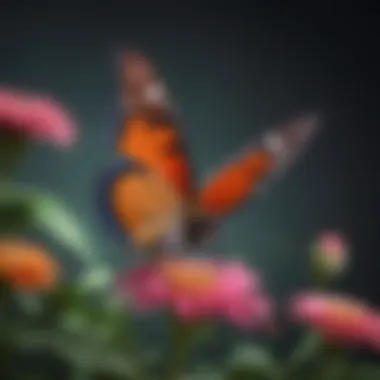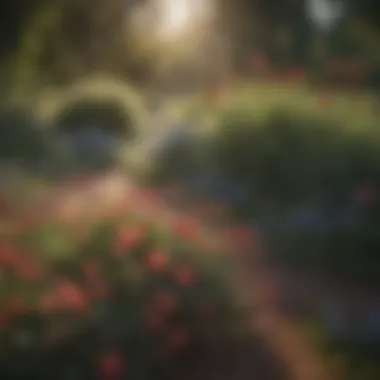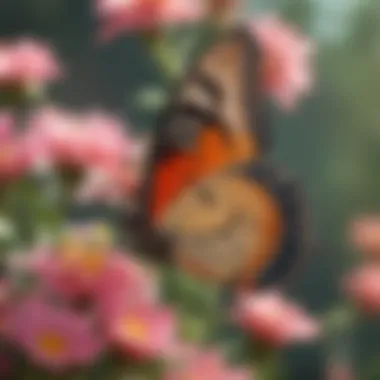Plants That Attract Butterflies for Your Garden


Intro
Creating a vibrant outdoor space that attracts butterflies is more than an aesthetic pursuit; it’s a pathway to enriching biodiversity. One might think planting a few flowers is enough to entice these graceful creatures, but the reality is far richer and more nuanced. In this guide, we will explore optimal plants tailored to attract various butterfly species, diving into their unique preferences.
By the end of this exploration, you'll understand the ecological significance of native flora and how to provide a haven for butterflies in your backyard. This isn’t just about planting pretty flowers; it’s about curating a living ecosystem that invites color, movement, and life into your outdoor realm.
Let’s embark on this journey to unveil the secrets behind a butterfly-friendly garden.
Understanding Butterfly Preferences
Understanding butterfly preferences is crucial for creating an inviting outdoor space that captivates these delicate creatures. Butterflies are not just beautiful; they play an important role in pollination, contributing to the health of various plants. Hence, knowing what attracts them can help you foster a more biodiverse garden.
When thinking about butterfly-friendly gardens, it’s essential to consider what nourishes these insects. Different species have varying tastes and needs. The correct combination of plants can attract adult butterflies directly while also providing a safe haven for their developing larvae. Understanding their preferences not only enhances your garden’s aesthetics but supports local ecosystems as well.
The Importance of Nectar Sources
Nectar sources are akin to buffet tables for butterflies. Adult butterflies primarily feed on nectar from flowers, relying on these sugary solutions to gather the energy necessary for flight and reproduction. The right nectar-producing plants can dramatically increase the likelihood of attracting butterflies to your garden.
Popular nectar sources include:
- Milkweed - Besides its role as a host plant for monarch caterpillars, milkweed attracts a variety of adult butterflies.
- Coneflowers – Resilient and visually striking, they can bloom from summer into fall, maintaining a consistent food source.
- Butterfly Bush (Buddleja) – Known for its intoxicating scent and vibrant flowers, the butterfly bush is often a gathering point for these winged beauties.
"Choosing a variety of nectar-rich flowers ensures you have constant visitors throughout the blooming season."
To maximize nectar availability, it's beneficial to select plants that bloom at different times of the year. This careful planning ensures that butterflies have a continuous supply of food, allowing you to maintain a vibrant and lively garden ambiance.
Moreover, consider group planting—clusters of the same species create a more visually appealing arrangement and facilitate easier feeding for butterflies. Environmentally speaking, incorporating native plants is crucial as these flora are more adapted to local butterfly species, thus optimizing attractiveness while also fostering biodiversity.
Host Plants for Butterfly Larvae
While adult butterflies feast on nectar, their larvae—commonly known as caterpillars—have different dietary needs. Host plants are essential for the growth and development of these caterpillars. Each butterfly species has specific preferences when it comes to host plants, making this component an integral aspect of your garden's ecosystem.
For instance:
- Milkweed is the sole food source for monarch caterpillars, making it a necessary addition for anyone looking to support this striking butterfly.
- Fennel, parsley, and dill are highly favored by swallowtail caterpillars, while brassicas like cabbage and mustard attract various species as well.
Caterpillars often camouflage themselves on these plants, making them somewhat elusive. As such, it’s a good idea to place these host plants in sheltered areas of your garden.
By creating a landscape that supports both adult butterflies and their larvae, you can ensure a thriving butterfly population while adding unique visual interest to your space. A well-thought-out garden will not only bring peace but also foster a deep connection between your outdoor living environment and nature itself.
Types of Plants that Attract Butterflies
Butterflies are mesmerising creatures that add a splash of colour and life to any outdoor space. When creating a butterfly-friendly garden, it's crucial to understand that not all plants are created equal. The right selection of flora is vital for attracting these delicate beings to your yard. This section explores various plant types that are magnet for butterflies and how to use them effectively.
Nectar-Producing Flowers
Nectar-rich flowers are the lifeblood of butterfly gardens. These blooms provide the energy butterflies need for their daily activities and reproductive cycles. Think of these flowers as the sweet dessert after a hearty meal—so enticing they just can’t resist!
Popular nectar-producing flowers include:
- Milkweed: This splendid flower is a top choice for Monarchs, serving as both a nectar source and host plant.
- Echinacea: Known as the Coneflower, this perennial not only brings butterflies, but also adds a charming wildflower feel to your garden.
- Lantana: Its bright orange, yellow, and red blooms are both eye-catching and highly attractive for various butterfly species.
When planting nectar flowers, consider grouping them together. A mass of colour makes it easier for butterflies to spot their favoured flowers. Plant in clusters of three or more, ideally with similar heights to create a natural flow.


Native Plants and Their Benefits
Introducing native plants into your garden is like inviting local butterflies to a friendly gathering—they're familiar with their environment and know just where to find the best offerings. Native plants require less water and maintenance since they are adapted to the local climate. They also attract a wider range of pollinators.
Benefits of using native plants include:
- Environmental Adaptation: Naturally thrive in the stormy weather and harsh conditions that might come and go.
- Supporting Local Ecosystems: Help sustain birds, bees, and other wildlife, making your garden more vibrant.
- Biodiversity Boost: Enhance overall ecosystem health, providing food and shelter for various butterfly species.
Consider integrating plants like Black-eyed Susan or Wild Bergamot, which not only support butterfly populations but also offer a touch of elegance to your garden. Their colors and fragrances can entice both butterflies and human visitors alike.
Annuals versus Perennials
Understanding the difference between annuals and perennials is crucial for planning a butterfly garden that’s both beautiful and functional.
Annuals, such as marigolds and zinnias, provide vibrant blooms for just one growing season but can be replanted each year for fresh colour. These plants often have longer flowering seasons, drawing butterflies in right through until frost. They offer more flexibility with seasonal colour changes but require more upkeep.
Meanwhile, perennials, like asters and phlox, will return year after year with low maintenance once established. While their blooms may last a shorter time compared to annuals, they provide a solid foundation in your garden and become more robust over time.
"A well-planned butterfly garden is a tapestry of blooms, weaving together both annuals and perennials for continuous beauty throughout the seasons."
In deciding what to plant, consider your main goal: do you want an ever-changing landscape with annuals or a stable garden filled with perennials? Each type offers advantages worth considering, so tailor your choice to the environment and time you are willing to invest.
By choosing the right plants, you elevate not just the attractiveness of your garden, but also create a vital sanctuary for butterflies, enriching the experience for both these remarkable creatures and the people who enjoy observing them.
Specific Plants that Draw Butterflies
Creating a sanctuary that attracts butterflies goes beyond mere aesthetics; it's about weaving together nature's rich tapestry. When choosing specific plants, it's crucial to consider not only their beauty but also their role in cultivating a habitat that welcomes these exquisite creatures. Tailoring your garden with the right mix can enhance the vibrancy of your outdoor space while contributing to the ecological fabric of your environment.
Milkweed Varieties
Milkweed isn't just a pretty face; it holds a crucial spot in the ecosystem, particularly for the Monarch butterfly. Not all milkweeds are created equal, though. Common Milkweed (Asclepias Syriaca) offers ample nectar and is a preferred host for Monarch larvae, making it essential for their life cycles. Besides, its pleasant fragrance adds an alluring touch to gardens. Another noteworthy variety is Swamp Milkweed (Asclepias incarnata), which thrives in moist soil. Known for its pink blooms, this variety is both a nectar source and host to several other butterfly species, aiding in diversity.
Planting a variety of milkweed species ensures a continuous bloom throughout the growing season, fostering an inviting environment for butterflies. A small patch of milkweed can truly become a butterfly haven, transforming your garden intro a vibrant ecosystem.
Butterfly Bush
The Butterfly Bush (Buddleja Davidii) is a popular choice among butterfly enthusiasts. This shrub’s tubular flowers are irresistibly attractive to butterflies, and its long blooming period spans from summer to fall. It's worth mentioning that this bush can spread swiftly, so proper maintenance and placement are necessary. While certain varieties are more invasive than others, new cultivars focus on being non-invasive while still providing abundant nectar and visual appeal.
Butterfly bushes are not just functional; they can serve as architectural features in your landscaping. Their varied heights and shades, ranging from lilac purple to bright yellow, offer an eye-catching focal point while supporting various butterfly species. Plant them in clusters for maximum visibility and attractivity.
Coneflower and Black-eyed Susan
Both Coneflower (Echinacea) and Black-eyed Susan (Rudbeckia Hirta) hold their own as staples in any butterfly garden. Coneflowers, with their daisy-like petals, not only attract butterflies but also serve as an excellent remedy for allergy sufferers. Black-eyed Susans, on the other hand, are famous for their striking yellow petals that shake off the blues of any gloomy day. Both these plants are perennial, offering repeated blooms that come back year after year, providing consistent sustenance for butterflies.
Using these flowers in your garden provides a hardy, drought-resistant option. Their resilient nature means they can withstand harsh conditions, ensuring that your garden can still attract butterflies even in less-than-ideal weather.
Lantana and Its Appeal
Lastly, let’s talk about Lantana. This plant is a dynamo in attracting butterflies thanks to its small clusters of bright flowers that appear in varying colors from yellow to orange and red. Native to tropical regions, Lantana thrives in warm climates and can handle less moisture than other plants. While it may not be the best option in cooler areas, it can be a magnet for butterflies in the right setting.
Its sprawling nature makes it suitable as ground cover as well. However, don’t forget that Lantana can be invasive in some zones, so keep an eye on its growth and control its spread when necessary. Lantana not only enriches the biodiversity of your garden but also contributes to a lively and colorful panorama.
"Creating spaces for butterflies requires thoughtful selection of plant varieties that serve both aesthetic and ecological functions."


In summation, the selection of specific plants greatly influences the possibility of attracting butterflies. Milkweed, Butterfly Bush, Coneflower, Black-eyed Susan, and Lantana all play vital roles in this endeavor. By focusing on these plants, you can cultivate a beautiful and vibrant garden that butterflies will flock to, enriching both the environment and your outdoor experience.
Creating a Butterfly Habitat
Establishing a haven where butterflies can thrive is one of the most rewarding aspects of gardening. Not only does it attract these graceful creatures, but it also creates a vibrant ecosystem. A well-thought-out butterfly habitat goes beyond just planting flowers; it involves a thoughtful approach to layout, sunlight, water sources, and minimizing environmental impacts.
Creating this type of environment encourages not just butterflies but a myriad of other pollinators, benefiting plant life and contributing to biodiversity. Here, we delve deep into the specific elements that can transform a regular garden into a tranquil butterfly sanctuary.
Layout Considerations
When planning your butterfly habitat, consider the layout. Design your garden to provide a mixture of open spaces and sheltered areas. Butterflies enjoy sunny spots to warm their wings, but they also need protection from strong winds and predators. Positioning taller plants along the perimeter can serve as natural barriers.
- Meandering Pathways: Create pathways that invite exploration, providing different vantage points for butterfly watching.
- Plant Grouping: Group plants in clusters rather than spreading them out. This technique not only makes them more visually appealing but also helps butterflies easily find their preferred nectar sources.
- Microhabitats: Include rocks, logs, or mulch in your layout. These elements add varying textures to your space and serve as sunbathing spots for butterflies, particularly in the early morning.
The Role of Sunlight and Water
Sunlight is crucial to attracting butterflies. These insects are cold-blooded and require warmth to be active. Consider the orientation of your garden in relation to sunlight.
- Sunny Spots: Ensure there are ample sunny areas, particularly in the spring and summer. Aim for at least six hours of sunlight per day.
- Water Resources: Butterflies also need water, not just for drinking but also for reproductive purposes. Incorporate shallow dishes with pebbles so they can perch safely while sipping water. Adding a small fountain can create a smooth-sounding oasis, drawing more butterflies to your space.
Minimizing Chemical Use
In today's gardening practices, there's a pressing need to reduce the use of harmful chemicals. Butterflies are extremely sensitive to pesticides, and exposure can be fatal.
- Organic Alternatives: Consider organic gardening methods. Use neem oil or insecticidal soaps as safer options when dealing with pests.
- Natural Predators: Embrace natural pest control options by introducing birds and beneficial insects to the environment. Their presence can mitigate the need for chemical interventions.
- Education and Awareness: Engaging with your local gardening community can yield insight into sustainable practices that align with your goals of creating a butterfly-friendly habitat.
"Creating a butterfly habitat not only enhances the beauty of your garden but also supports the ecological balance, paving the way for a flourishing natural environment."
Through these careful considerations regarding layout, sunlight, water, and chemical use, you can cultivate a butterfly habitat that invites not just butterflies, but an entire ecosystem into your garden. This transformation is not just about aesthetics; it's about fostering a deeper connection with nature.
Timing for Planting and Maintenance
The relationship between butterflies and the plants around them is far from arbitrary. Timing plays a crucial role in creating an environment hospitable to these delicate insects. By synchronizing your planting schedule to the life cycles of butterflies and considering seasonal changes, you enhance your garden's appeal while accommodating the local butterfly species. Understanding when and how to plant is not only a matter of aesthetics, but of establishing a thriving ecosystem.
Different butterflies emerge at various times of the year, influenced largely by the climate and local ecosystems. Long-term planning is key. Just as a chef requires the right ingredients at the right time for a gourmet dish, gardeners must align their plantings with butterfly activity. This foresight ensures that food sources are available when they are most needed.
"Timing is everything. A garden can be a feast for the eyes but without careful planning, it can be a desert for butterflies."
Seasonal Planting Strategies
When planting for butterflies, consider the seasons. Each season offers unique opportunities to introduce or maintain butterfly-attractive flora. Spring is typically a prime time for planting many flowers and nectar sources; as butterflies emerge from their overwintering phases, freshly bloomed plants provide nourishment.
- Spring: Initiate your butterfly garden in spring. This is the ideal time to sow seeds for nectar-rich flowers, such as Lantana, Aster, and Coneflower. These flowers will bloom through summer, offering food sources for adult butterflies.
- Summer: While summer gardening requires diligence, it’s a chance to evaluate and expand. Observe which plants thrive under the sun and which don’t. Consider adding late bloomers like Goldenrod or Joe-Pye Weed to keep the buffet open for migrating species.
- Fall: Autumn can be a gentle reminder to prepare for the coming seasons. Consider planting Milkweed late in the season for overwintering caterpillars. It's also a good time to tidy up the garden, removing debris but leaving some dead stems standing; they can provide habitat for creatures throughout winter.
- Winter: While not a prime planting season, winter is crucial for planning and research. Utilize this time to study your local butterfly species' habits and to create a blueprint for your garden. Consider which plants provide the most benefit and adapt your strategy accordingly.
Year-Round Care
Once your garden is lush with butterfly-attracting plants, the attention doesn’t stop there. Continuous maintenance is paramount. Healthy plants translate to healthy ecosystems. Regular tasks such as watering, weeding, and occasional pruning help keep your garden vibrant and nourishing.
- Watering: A consistent watering schedule is essential, particularly in the heat of summer. Butterflies prefer gardens that are well-hydrated, as are the flora they frequent. Early mornings or late afternoons are the best times to water to minimize evaporation.
- Fertilizing: While butterflies may not benefit directly from fertilizer, the plants do. A well-fed nectar plant will have more vibrant blooms, thus attracting more butterflies. Use organic fertilizers to ensure that you aren’t introducing harmful chemicals to the environment.
- Weeding: Unwanted plants can choke out the ones meant to attract butterflies. Regular weeding ensures that your targeted plants have enough room to flourish.
- Observation: Pay attention to which butterflies visit your garden and when; patterns will emerge over time, and this knowledge informs future planting decisions.
In summary, the timing of planting and ongoing maintenance is pivotal in nurturing a butterfly-friendly environment. By harmonizing your garden with the life cycles of butterflies and adopting a proactive, year-round care routine, you not only entice butterflies into your space but also create a flourishing ecosystem that nurtures a variety of local wildlife.
Observing Butterflies


Observing butterflies is an enchanting experience that ties closely into gardening and attracting these delicate creatures. Taking the time to notice how butterflies interact with your space not only enhances your connection to nature but also provides valuable insights into ecological health. Seeing these creatures flit from flower to flower can be rewarding. They are not just beautiful; their presence indicates that your garden is thriving, filled with the right plants and flourishing biodiversity.
The act of observation encourages you to be more mindful of your outdoor environment. It compels a deeper awareness of the changes in seasons, plant cycles, and the types of butterflies visiting your space. This gives you a chance to adapt your gardening strategies, ensuring that you’re continually supporting a vibrant butterfly habitat. Watching these insects can also spur personal reflection and appreciation for the intricate web of life surrounding us.
Best Times for Viewing
Fishing for butterflies requires a keen sense of timing. Generally, these lovely insects are most active during warm, sunny days, especially when the temperature stretches above 70 degrees Fahrenheit. Early morning hours, when the sunlight bathes the garden in a golden hue, are particularly rewarding. You’ll often see butterflies basking on flowers to soak up heat before they flutter around.
Butterflies tend to feed between late morning and early afternoon, making this the prime period for their active display. If you have a penchant for photography or simply want to take in the sights, timing your observation accordingly can make a substantial difference. Here are a few tips to maximize your experience:
- Be Patient: Butterflies may take their time arriving, so lingering quietly can enhance your chance of a sighting.
- Stay Still: Sudden movements can scare these skittish insects away, making it important to be as unobtrusive as possible.
- Visit on Sunny Days: Butterflies are sun worshippers; thus, sunny conditions bring them out in droves.
- Observe Specific Plants: Pay attention to plants you've specifically chosen to attract butterflies. You might find yourself captivated by their deliberate dance amongst fragrant blooms.
Identifying Local Species
Understanding which butterfly species are common in your locality allows for a more tailored approach in creating a butterfly-friendly space. Not all butterflies are created equal; different species have specific preferences for nectar plants and habitats. Observing butterflies in your area can help you identify which varieties frequent your garden.
- Research Local Species: Areas often have regional guides to butterflies. Check resources like Wikipedia or local nature centers for insight.
- Document Your Findings: Keep a journal or take pictures to track which species you observe. This can enhance your gardening experience.
- Engage with Communities: Local gardening clubs or online forums such as Reddit can be useful in sharing discoveries and getting tips on identification.
By learning to identify local butterfly species, you can better cater your garden to meet their needs and expectations. The rewarding connection you build with these creatures is not just an aesthetic pleasure; it serves as a means of promoting ecological awareness and responsibility in your own backyard.
The Ecological Impact of Butterfly Gardens
Creating a butterfly garden does more than just beautify your outdoor space. It can play a significant role in supporting ecosystems. Butterfly gardens foster an environment where these delicate creatures can thrive and flourish, contributing to the larger ecological framework. In today’s world, where biodiversity is under constant threat, understanding the impact of these gardens is crucial.
Encouraging Pollination
Butterflies are essential pollinators, similar to bees. They busily flit from flower to flower, sipping nectar while playing a part in the reproductive cycle of plants. This insect engagement isn't merely coincidental; it’s a symbiotic relationship, vital for many flowering plants. For instance, when butterflies visit flowering plants such as the zinnia or the milkweed, they help transfer pollen, which aids in seed development and plant reproduction.
This natural process supports the growth of various plants, ensuring that gardens remain vibrant and healthy. Furthermore, these gardens can also enhance food production. A study found that farms with nearby butterfly habitats reported higher yields. Evidence points strongly to the notion that a more pollinator-friendly garden directly correlates with abundant crops. It’s a beauty-enhancing, ecosystem-supporting cycle that benefits all.
Supporting Biodiversity
Not just butterflies benefit from these gardens. By providing a sanctuary of native plants, butterfly gardens create habitats for other wildlife—be it bees, birds, or even small mammals. Native plants offer there source of food and shelter for various species, promoting greater biodiversity. This multiplicity doesn’t only support the creatures directly involved but helps stabilize the entire ecosystem. A diverse range of species can contribute to a more resilient environment.
Moreover, enhancing biodiversity means less dependence on chemical fertilizers and pesticides. Native plants typically require less maintenance, as they are adapted to the local climate and soil conditions. This reduces the need for chemicals that may harm delicate butterflies and other beneficial insects.
"By focusing on native species in our gardens, we pave the way for a healthier ecosystem, which eventually supports our role as caretakers of the environment."
In essence, the ecological impact of butterfly gardens stretches far beyond their aesthetic allure. They serve as critical environments that nurture both flora and fauna, enabling a flourishing community of life. Therefore, setting up a butterfly garden is not only an act of beauty; it’s a conscious step toward ensuring a sustainable planet.
End and Reflections
Creating an environment that draws butterflies is not just about aesthetic values; it is a meaningful contribution to ecological balance. A butterfly garden showcases the intricate relationships among different species and the essential role they play in pollination. This connection supports not only butterflies but also a plethora of other wildlife, enriching our understanding of nature's interdependence.
Encouragement for Gardeners
To all the gardeners out there, whether you are seasoned pros or fresh to the scene, your efforts are vital. Nurturing a butterfly garden is more than just planting flowers; it requires a certain mindset. Embrace the idea of a living canvas, a work in progress that may take time to flourish.
When you select plants that are attractive to butterflies, consider their life cycles and needs. Incorporating host plants is essential. You’ll not only provide nectar for the adults but also foster the larvae that will grow into the next generation of these delicate beings. Getting your hands dirty can lead to observations that inspire you—like seeing the Monarch caterpillar munching away on milkweed or a Swallowtail gliding gracefully through a patch of flowers.
In supporting butterfly populations, you can also support your mental well-being. Watch how these colorful insects dance from flower to flower, and allow their presence to create a meditative atmosphere. This simple act can enhance your outdoor space, transforming it into an oasis of tranquility.
Future Considerations for Sustainable Gardening
As we look ahead, it’s prudent to consider the long-term implications of fostering these vital insects. Being mindful of our choices in the garden can directly impact the environment, particularly in a world ever more threatened by climate change and habitat loss. You might want to opt for plants native to your region, as they generally require less maintenance and are more adaptable to local conditions.
Additionally, integrating permaculture principles could be a wise step. By creating a self-sufficient ecosystem, one that mimics natural systems, you can help ensure your butterfly garden remains vibrant and healthy year after year.
Also, remain open to exploring different gardening techniques. Consider using organic methods and limiting the use of chemicals—these adjustments can create a safer haven for butterflies and other creatures alike. Your garden should be a sanctuary, not just for you, but for every living thing that visits.
In summary, cultivating a butterfly-friendly environment is an investment in our natural world. So let's dig in, plant with purpose, and reflect on how our gardens can become vibrant hubs of life and activity.







